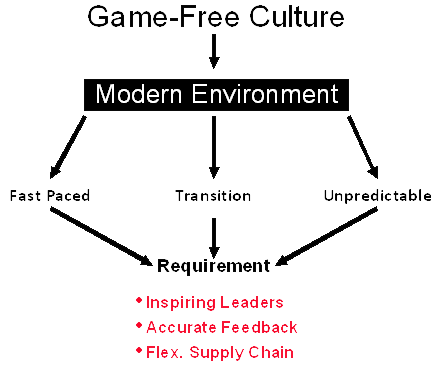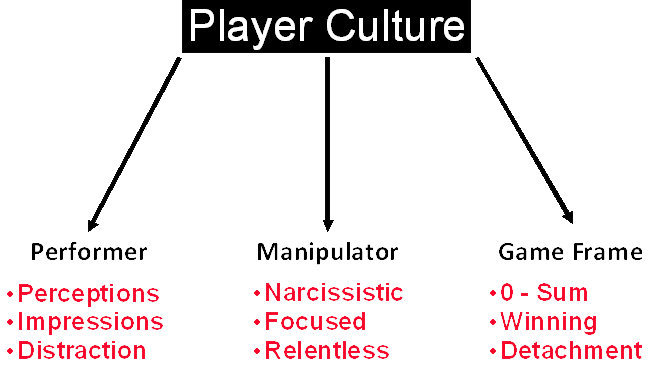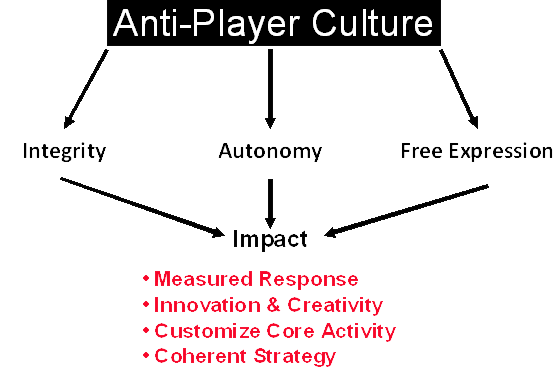Problem:
The world has changed. To add insult to injury, it keeps changing. Change is the new constant.
In response we search for ever more creative applications of the same old rules; but they just do not do the job.
In frustration we seek "out of the box" solutions, oblivious to the fact that we are still clinging to the box we are in.
Could it be that we are all barking up the wrong tree?
What we have to do:
The only way to effect true sustainable change in an organization, community, or an entire society is to shift its
consciousness. New technologies and new management techniques will improve the way and means - increase economy, efficiency,
and effectiveness, but in the end they are nothing more than new ways of doing the wrong thing.
It is not the modus operandi but the modus vivendi that we need to change.
Unlike learning new skills, shifting consciousness is not a linear task that can be broken down into a sequence of
measurable milestones. It happens in the blink of an eye, yet decades can pass before that blink takes place.
Current management theories focus on the ways and means and do not really attempt to address the consciousness.
What is referred to as a shift in culture is typically tearing down one box only to replace it with another.
For example, there is no direct approach to attaining happiness. The more you chase it, the more it eludes your grasp.
The same principle applies to raising corporate consciousness. The moment that it is stated as an explicit objective,
it becomes the fountainhead of yet another layer of impression management, which then creates a push in the opposing direction.
There seems to be a commonly held misconception that higher consciousness is synonymous with meditation, natural foods,
abundant body hair and sensible footwear. From personal experience with groups from all over the political and social
spectrum - be they accountants, private school alumni, therapists, or pseudo-mystics - each was dominated by its own
signature groupthink.
Those of higher consciousness are defined by their capacity for original thought or expression. This is not a function of
training so much as of innate capacity. In this sense it is not dissimilar from outstanding musical talent, or athletic
prowess. Typically these people will be very uncomfortable in most highly organized social settings. They tend to be oblivious
to group dynamics, and will either be perceived as too loud and disruptive, or will fall mute and disappear into the woodwork.
In either case their contribution will typically be either marginalized or ignored. If I possess one special gift, it is in
being able to identify these individuals and helping them in bringing their best forward.
The most immediate benefit will be a continuous stream of actionable projects that will immediately improve the flow of work
in the organization. This will then impact both the productivity and the morale of those in the work environment.
In the longer term, the indirect, yet primary, benefit is in shifting the consciousness of the entire organization.
A value proposition such as this can only be validated in situ, not with metrics but with tangible results.
This process is also transferable and can be embedded within the organization going forward.

What stands in the way?
Machiavelli's The Prince was a kind of playbook for the Game, more specifically the Hidden Game. This concealed
dynamic lies hidden beneath the surface wherever power, wealth, and status are at stake. Nevertheless, Machiavelli's
basic premise is that the Game and Life are synonymous. Like a Russian doll, this is the Hidden Game within his book
on the Hidden Game. It seduces the reader into buying into the basic premise that Life always was, and always will be,
the Game. My basic contention is quite the opposite. The Game, as I see it, is a kind of magician's trick played on all
of us. All we need do is wake up, in order to free ourselves once and for all from its penury.
On the chessboard of my version of the Game we are allocated one of two roles - Player and Drone. The Players are those
who enjoy an innate understanding of the Game. They are social magicians, managing impressions and perceptions brilliantly;
expert at navigating their way around the chessboard, bending reality to suit their needs. The Drones, on the other hand,
are oblivious to the deeper Game and live their lives believing in the sanctity of Church and State, compliant to the bitter end.
There is, however, a third type of individual. They are unable, or unwilling, to conform and become a Drone, while having no
aspiration to join the ranks of the Players, These are the AntiPlayers (referred to as Masters in the book). AntiPlayers come
in all shapes and sizes. Nonetheless, that which they all have in common is an innate sense of essence: a core belief that
there is much more to life than the simple chessboard offered by the Game. This strong sense of a Higher Truth is what makes
it impossible for them to fully buy in. They are, as one might expect, as unskilled at navigating the Game as the Players are
skilled. The AntiPlayer experiences the Game as a kind of prison from which they cannot escape.

In order to manage the Game easily and efficiently, the Players set up a kind of structure that I refer to as the Circle Square
Pattern. The Circle represents the upper echelon, the Game's insiders. This realm is exclusively occupied by Players.
The Square represents the box inside which all who are not Players are confined. The box is a special kind of prison in which the
inmates police themselves.
Over the fullness of time the Players grow richer, more entitled, and more controlling. The Drones become increasingly rigid, and
more deeply entrenched within the organizational 'groupthink'. The AntiPlayers are progressively moved farther and farther away
from the center, in the process becoming frustrated, demoralized, and alienated.
Meanwhile, the organization becomes steadily more top heavy, bureaucratic, and unproductive, all the while becoming progressively
more out of step with the world around it. This phenomenon is depicted in my book on the organizational level; however it applies
equally at the sector, and societal levels. Ultimately, it extends to the entire human condition.
My process can be best thought of as being directed at unlocking the organization's latent potential by breaking the hold that
this Game has upon it. The organization that succeeds in doing this will not only be ahead of the curve, it will find itself in
an entirely new paradigm. As such it will enjoy an insuperable edge over its competitors.
As a footnote, there is a fourth character on the stage - that of the CounterPlayer. This is the AntiPlayer who has become skilled
at the Game. Not just playing the Hidden Game, but playing beyond it. They are able to finesse the Player's right move with right
action. To the outside world CounterPlayers present as Players. To the untrained eye the two are indeed almost indistinguishable.
The one tell, however, is that slightest degree of eccentricity that the AntiPlayer can never fully conceal and always peeks through.
The solution:
At this juncture, the reader is likely to conclude that the solution toward which I am driving involves reversing the skew, thereby giving
the Outsider the edge over the Player.
Such a resolution, even to the extent that it would be achievable, would be neither sustainable nor desirable. By advocating for
the Outsider and clipping the wings of the Player, we might, in the short run at least, increase innovativeness, and make the
workplace into a much kinder and saner place. However, it will remove the elements necessary for creative dynamic tension to be
achieved and maintained.
This is precisely the problem that plagued communities such as the hippie communes of the 60s and many of the social experiments
carried out in the New World by social visionaries hoping to create Utopia. They relied heavily upon consensus and the innate
goodness of each individual in the community, while eschewing the discipline of commercial reality. The almost inevitable result
was that the centrifugal force of individual expression overwhelmed the gravitational pull of the need for common cause.
The result was that the groups dissipated and dissolved over time.
The Players play a vital role in the optimal organization. They provide a restrictive opposing force that marshals the creative
initiatives of the Outsiders, securing the organization on the catwalk between inertia on the one hand, and chaos on the other.
On the external front, they are an invaluable asset in engaging with the various stakeholders - customers, bankers, regulatory
bodies, competitors, and suppliers - all charter members of the Player-driven paradigm that pervades commercial reality in any
part of the world.
The objective then is to introduce a kind of wedge - a restrictive element that leaves the Players largely in place, while
preventing them from completely marginalizing the Outsiders. The mechanics would include the Creation of a protective cell
wherein the Outsiders would be free to interact and contribute in ways consistent with their nature and temperament.
The next step will be to assemble the selection of Outsiders in a casual, informal setting outside the organization.
A local pub or café can serve admirably for this purpose.
Once the group has assembled, the consultant's role will be to ensure that the flow of composition should be as easy and natural
as possible. Then the focus shifts to generating a stream of actionable projects directed at improving the quantity and quality
of the transactional flow within the organization.

As opposed to the traditional change management approach which starts from the center of the organization and works its way
outwards, this model is applied in the opposite fashion. Initially the technique is applied to peripheral areas within the
organization on a random or piecemeal basis. At the outset it will only be the Outsiders who are directly impacted by the
transition. However, as the projects are being implemented, Reluctant Troopers will start to participate in the process as well.
Once a sufficient proportion of this population becomes actively engaged, critical mass will be achieved. At this point, the
organization will experience a spontaneous shift in consciousness. This will be evidenced by a precipitous increase in the rate
of change that will seemingly instantaneously bring about a complete shift in consciousness - the birth of the fully conscious
organization.


 BerlingHardy@gmail.com
BerlingHardy@gmail.com
 Bahman@Canaglobe.ca
Bahman@Canaglobe.ca